Addendum: Apparently all Dynafit bindings with brakes may be going to this “permanent” brake configuration. If you want the old style slide on/off brakes better get ’em while they’re hot. Shop for Dynafit ski brakes here if you so desire.
Sometimes the “inline” changes manufacturers make are surprising. Indeed, a tingle ran up my leg when I saw Dynafit has made the brakes on their Radical series binding nearly impossible for the average consumer to remove. The tingle was a good thing, as the previous brake design required a retainer clip to install properly, and that little retainer clip was often lost or never installed in the first place resulting in ski brake sliding off the binding during the middle of your tour. More, now that the Radical heel requires an anti-rotation stop to be mounted on the brake retractor disk, you actually cannot run this binding without the brakes — if you don’t want a brake you need to retain the parts that interact with the binding and simply cut the legs off. So in that sense too, you might as well have the brake permanently installed.
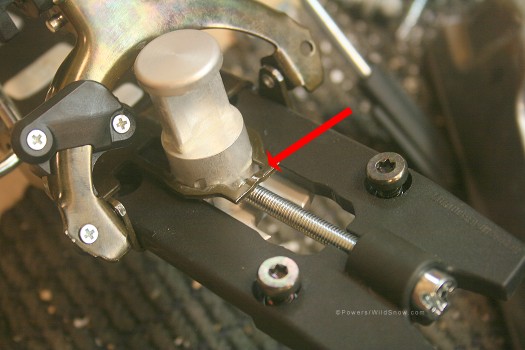
Trapped brake of latest Dynafit Radical FT/ST series bindings. For different width brakes you'll need to buy different base plates and brake combos.
But I also got a chill when I saw this, since one of the best features of most Dynafit bindings has been the easy brake swapping you can do even with the binding mounted on a ski. Really quite ingenious. Simply pop the heel unit off, flick the retainer clip, slide brake forward off the binding base plate.
Please know that the way Dynafit intends customers to do brake width swaps for the Radical FT/ST is you’ll buy a set of base plates with the pre-installed brakes. That’ll be $79.95 MSRP and require both unmounting and partial disassembly of the heel unit. (Note that a handy DIY person can swap brake legs, even from other brands of brakes.)
While Dynafit says the way you will change brake width with this new fixed-brake setup is to purchase additional complete heel units, you can swap the brake arms or revert back to the removable brake. See photos below.
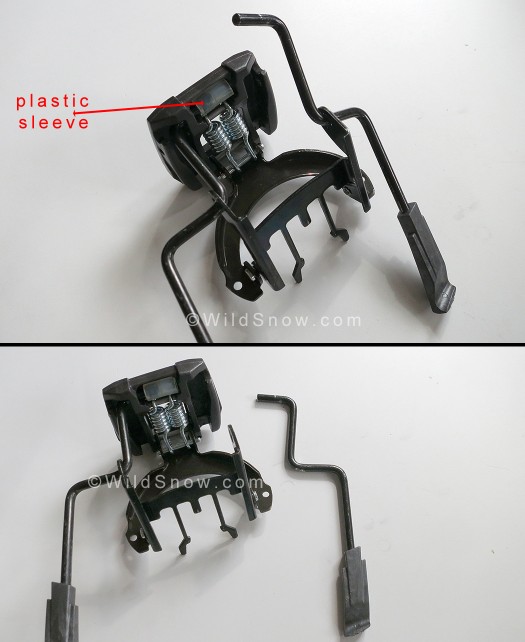
Dynafit brake arm swap is 'sort of' easy, just yank the short end out of the plastic sleeve -- do one at a time. Much tougher with brake mounted on the heel unit but it's quite easy getting them out of a free-standing brake unit as pictured. To remove and replace brake arms with brake attached to heel unit, you'll have to drive the pin out that holds the pair of small springs, or else unclip the springs from their anchor points. I've removed the arms by heavily prying on them but doing so is quite difficult and causes possible damage.
If you want to remove the brake entirely for whatever reason, follow the procedure below. (Again, know that presently the anti-rotation feature of the binding is part of the brake, so the below procedure may be next to useless for most people. We present it here for at least educational value.)
This one gets a 5/5 difficulty rating (most difficult) since it requires actually making a tool for the job as well as taking your bindings off the ski. I’m not sure if dealers could go this far. Perhaps it’s somewhat of a non-issue since most people will simply buy a binding for a given ski, and never need to extirpate the brakes from their bindings.
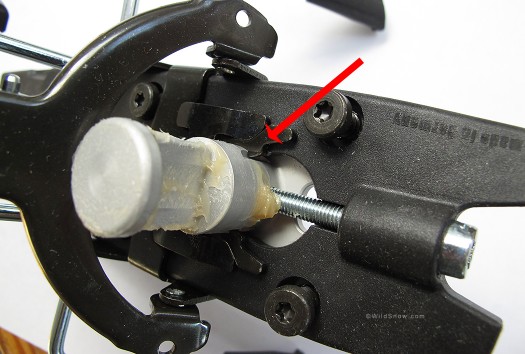
Previous brakes were retained by this clip system. They came off easily, which was a mixed blessing.
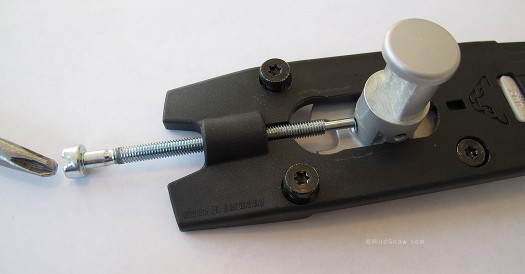
To remove the trapped brake, you have to back out the length adjustment screw--asier said then done as this screw is trapped with a thread locked nut that's difficult to get a wrench around.
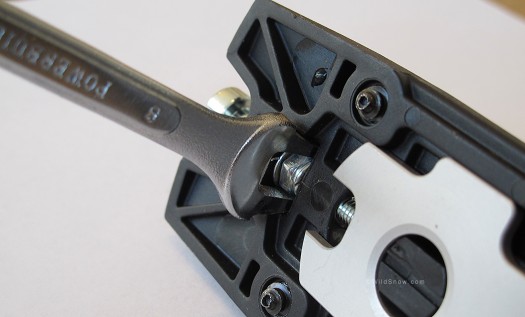
Looking at binding from underneath, it's necessary to hold the nut as shown while you back out the length screw. Thing is, a regular wrench won't fit in the small pocket where the nut resides. Solution: make your own wrench.
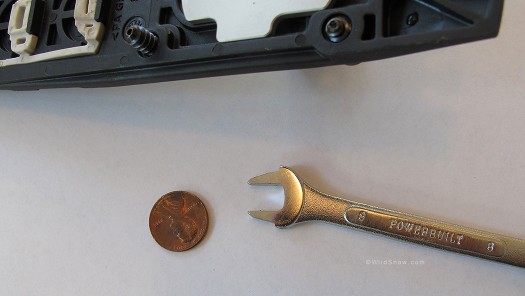
Official ANSI approved Dynafit nut removal tool is created from an 8 mm open end wrench, ground down to fit over the nut.
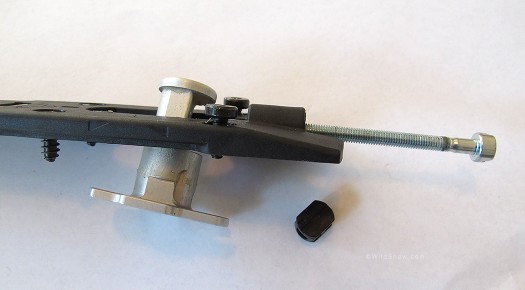
Once the screw is backed out the aluminum spindle post removes in obvious fashion. The black plastic is a threaded insert that goes in the base of the spindle. Reassembly is tricky. Use thread locker, and position the spindle at the front end of the binding plate when you start threading everything. If you thread the screw into the nut and thread the spindle from the correct position you'll end up not having as much adjustment range. Saving grace is if you're careful you can thread and unthread these parts multiple times. A power driver helps, but keep it on low speed so you don't heat up the plastic insert.
I’m going to take a neutral stance on this inline design change. I like that the binding is more reliable and that the anti-rotation solution is “built in.” On the other hand, I’m starting to feel pretty nostalgic for the days of the Vertical ST and FT models with their easy swap brakes, little to no need for rotation stops, and overall simplicity. Luckily you can still shop for either binding, check here for that.
We’re anticipating questions about what width brakes the Radical bindings will be sold with. Here is the breakdown. Radical ST will be sold with all three size brakes, 100 mm, 110 and 130. Radical FT will only be sold with the 110 and 130. To use a 100 brake with the FT and retain that model’s special baseplate you’d need to use the complex procedure above.
WildSnow.com publisher emeritus and founder Lou (Louis Dawson) has a 50+ years career in climbing, backcountry skiing and ski mountaineering. He was the first person in history to ski down all 54 Colorado 14,000-foot peaks, has authored numerous books about about backcountry skiing, and has skied from the summit of Denali in Alaska, North America’s highest mountain.
